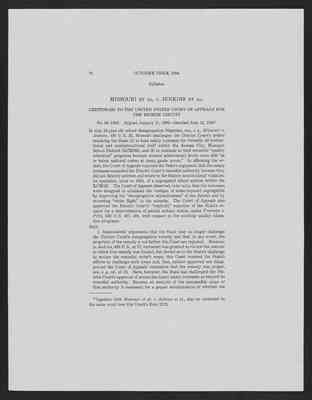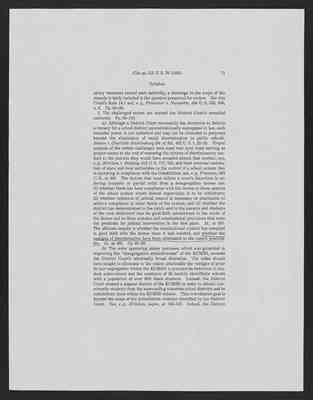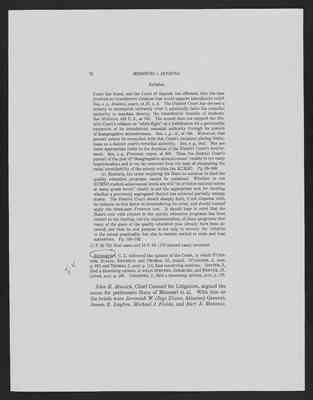Pages
11
70 OCTOBER TERM, 1994
Syllabus
MISSOURI ET AL. v. JENKINS ET AL.
CERTIORARI TO THE UNITED STATES COURT OF APPEALS FOR THE EIGHTH CIRCUIT
No. 93-1823. Argued January 11, 1995--Decided June 12, 1995*
In this 18-year-old school desegregation litigation, see, e. g., Missouri v. Jenkins, 495 U.S. 33, Missouri challenges the District Court's orders requiring the State (1) to fund salary increases for virtually all instructional and noninstructional staff within the Kansas City, Missouri, School District (KCMSD), and (2) to continue to fund remedial "quality education" programs because student achievement levels were still "at or below national norms at many grade levels." In affirming the orders, the Court of Appeals rejected the State's argument that the salary increases exceeded the District Court's remedial authority because they did not directly address and relate to the State's constitutional violation: its operation, prior to 1954, of a segregated school system within the KCMSD. The Court of Appeals observed, inter alia, that the increases were designed to eliminate the vestiges of state-imposed segregation by improving the "desegregative attractiveness" of the district and by reversing "white flight" to the suburbs. The Court of Appeals also approved the District Court's "implici[t]" rejection of the State's request for a determination of partial unitary status, under Freeman v. Pitts, 503 U.S. 467, 491, with respect to the existing quality education programs.
Held: 1. Respondents; arguments that the State may no longer challenge the District Court's desegregation remedy and that, in any event, the propriety of the remedy is not before this Court are rejected. Because, in Jenkins, 495 U.S., at 37, certiorari was granted to review the manner in which this remedy was funded, but denied as to the State's challenge to review the remedial order's scope, this Court resisted the State's efforts to challenge such scope and, thus, neither approved nor disapproved the Court of Appeals' conclusion that the remedy was proper, see, e. g., id., at 53. Here, however, the State has challenged the District Court's approval of across-the-board salary increases as beyond its remedial authority. Because an analysis of the permissible scope of that authority is necessary for a proper determination of whether the
*Together with Missouri et al. v. Jenkins at al., also on certiorari to the same court (see this Court's Rule 12.2).
12
71 Cite as: 515 U.S. 70 (1995) Syllabus
salary increases exceed such authority, a challence to the scope of the remedy is fairly included in the question presented for review. See this Court's Rule 14.1 and, e.g., Procunier v. Navarette, 434 U.S. 555, 560 n. 6. Pp. 83-86. 2. The challenged orders are beyong the District Court's remedial authority. Pp 86-103. (a) Although a District Court necessarily has discretion to fashion a remedy for a school district unconstitutionally segregated in law, such remedial power is not unlimited and may not be extended to purposes beyond the elimination of racial discrimination in public schools. Swann v. Charlotte-Mecklenburg Bd. of Ed., 402 U.S. 1, 22-23. Proper analysis of the orders challenged here must rest upon their serving as proper means to the end of restoring the victims of discrimination conduct to the position they would have occupied absent that conduct, see, e.g., Milliken v. Bradley, 418 U.S. 717, 746, and their eventual restoration of state and local authorities to the control of a school system that is operating in compliance with the Constitution, see e.g., Freeman,, 503 U.S., at 489. The factors that must inform a court's discretion in ordering complete or partial relief from a desegregation decree are: (1) whether there has been compliance with the decree in those aspects of the school system where federal supervision is to be withdrawn; (2) whether retention of judicial control is necessary or practicable to achieve compliance in other facets of the system; and (3) whether the district has demonstrated to the public and to the parents and students of the once disfavored race its good-faith commitment to the whole of the decree and to those statutes and constitutional provisions that were the predicate for judicial intervention in the first place. Id., at 491. The ultimate inquiry is whether the constitutional violator has complied in good faith with the decree since it was entered, and whether the vestiges of discrimination have been eliminated to the extent practicable. Id., at 492. Pp. 86-89. (b) The order approving salary increases, which was grounded in improving the "desegrative attractiveness" of the KCMSD, exceeds the District Court's admittedly broad discretion. The order should have sought to eliminate to the extent practicable the vestiges of prior de jure segregation within the KCMSD: a systemwide reduction in student achievement and the existence of 25 racially identifiable schools with a population of over 90% black students. Instead, the District Court created a magnet district of the KCMSD in order to attract conminority students from the surrounding suburban school districts and to redistribute them within the KCMSD schools. This interdistrict goal is beyond the scope of the intradistrict violation identified by the District Court. See, e.g., Milliken, supra, at 746-747. Indeed, the District
13
72
MISSOURI v. JENKINS
Syllabus
Court has found, and the Court of Appeals has affirmed, that the case involved no interdistrict violation that would support interdistrict relief. See, e.g., Jenkins, supra, at 37, n. 3. The District Court has devised a remedy to accomplish indirectly what it admittedly lacks the remedial authority to mandate directly: th interdistrict trasfer of students. See Milliken, 418 U.S., at 745. The record does not support the District Court's reliance on "white flight" as a justification for a permissible expansion of its intradistrict remedial authority through its pursuit of desegregative attractiveness. See, e.g., id., at 746. Moreover, that pursuit cannot be reconciled with this Court's decisions placing limiations on a district court's remedial authority. See, e.g., ibid. Nor are there appropriate limits to the duration of the District Court's involvement. See, e.g., Freemen, supra, at 489. Thus, the District Court's pursuit of the goal of "desegregative attractiveness" results in too many impomderables and is too far removed from the task of eliminating the racial identifiability of the schools within the KCMSD. Pp. 89-100. (c) Similarly, the order required the State to continue to fund the quality education programs cannot be sustained. Whether or not KCMSD student achievement levels are still "at or below national norms at many grade livels" clearly is not the appropriate test for deciding whether a previously segregated district has achieved partially unitary status. The District Court should sharply limit, if not dispense with, its reliance on this factor in reconsidering its order, and should instead apply the three-part Freeman test. It should bear in mind that the State's role with respect to the quality education programs has been limited to the funding, not the implementation, of those programs; that many of the goals of the quality education plan already have been attained; and that its end purpose is not only to remedy the violation to the extend practicable, but aso to restore control to state and local authorities. Pp. 100-102. 11 F. 3d 755 (first case) and 13 F. 3d 1170 (second case), reversed.
REHNQUIST, C.J., delivered the opinion of the Court, in which O'CONNOR, SCALIA, KENNEDY, and THOMAS, J.J., joined. O'CONNOR, J., post, p. 103, and THOMAS, J., post, p. 114, filed concurring opinions. SOUTER, J., filed a dissenting opinion, in which STEVENS, GINSBURG, and BREYER, J.J., joined, post, p. 138. GINSBURG J., filed a dissenting opinion, post, p. 175.
John R. Munich, Chief Counsel for Litigation, argued the cause for petitioners State f Missouri et al. With him on the briefs were Jeremiah W. (Jay) Nixon, Attorney General, James R. Layton, Michael J. Fields, and Bart A. Matanic,
14
73
Cite as: 515 U.S. 70 (1995) Opinion of the Court Assistant Attorneys General, Carter G. Phillips, Mark D. Hopson, and Janet M. Letson. Theodore M. Shaw argued the cause for respondents. With him on the briefs for respondents Jenkins et al. were Arthur A. Benson II, James S. Liebman, and Elaine R. Jones. Allen R. Snyder, Patricia A. Brannan, John W. Borkowski, Scott A. Raisher, and Frederick O. Wickham filed a brief for respondents Kansas City, Missouri School District et al. Deputy Solicitor General Bender argued the cause for the United States as amicus curiae urging affirmance. With him on the brief were Solicitor General Days, Assistant Attorney General Patrick, Irving L. Gornstein, Dennis J. Dimsey, and Mark L. Gross.* CHIEF JUSTICE REHNQUIST delivered the opinion of the Court. As this school desegregation litigation enters its 18th year, we are called upon again to review the decisions of the lower courts. In this case, the state of Missouri has challenged the District Court's order of salary increases for virtually all instructional and noninstructional staff within the Kansas City, Missouri, School District (KCMSD) and the District Court's order requiring the State to continue to fund remedial "quality education" programs because student achievement levels were still "at or below national norms at many grade levels." _______________________ *Mark J. Bredemeier and Jerald L. Hill filed a brief for Icelean Clark et al. as amici curiae urging reversal. Briefs of amici curiae urging affirmance were filed for the American Civil Liberties Union et al. by Christopher A. Hansen, Steven R. Shapiro, and Helen Hershkoff; for the Civic Council of Greater Kanswas City by David F. Oliver; for the Lawyers Committee for Civil Rights Under Law by Jack W. Londen, Michael Cooper, and Thomas J. Henderson; and for James D. Anderson, et al. by Kevin J. Hamilton. William L. Taylor and Dianne M. Pich filed a brief for the National Urban League et al. as amici curiae.
15
74 MISSOURI v. JENKINS
Opinion of the Court
I A general overview of this litigation is necessary for proper resolution of the issues upon which we granted certiorari. This case has been before the same United States District Judge since 1977. Missouri v. Jenkins, 491 U.S. 274, 276 (1989) (Jenkins I.) In that year, the KCMSD, the school board, and the children of two school board members brought suit against the State and other defendants. Plaintiffs alleged that the State, the surrounding suburban school districts (SSD's), and various federal agencies had caused and perpetuated a system of racial segregation in the schools of the Kansas City metropolitan area. The District Court realigned the KCMSD as a nominal defendant and certified as a class, present and future KCMSD students. The KCMSD brought a cross-claim against the State for its failure to eliminate the vestiges of its prior dual school system. After a trail that lasted 7-1/2 months, the District Court dismissed the case against the federal defendants and the SSD's, but determined that the State and teh KCMSD were liable for an intradistrict violation, i.e., they had operated a segregated school system within the KCMSD. Jenkins v. Missouri, 593 F. Supp. 1485 (WD Mo. 1984). The District Court determined that prior to 1954 "Missouri mandated segregated schools for black and white children." Id., at 1490. Furthermore, the KCMSD and the State had failed in their affirmative obligations to eliminate the vestiges of the State's dual school system within the KCMSD. Id., at 1504. In June 1985, the District Court issued its first remedial order and established as its goal the "elimination of all vestiges of state imposed segregation." Jenkins v. Missouri, 639 F. Supp. 19, 23 (WD Mo. 1985). The District Court determined that "[s]egregation ha[d] caused a system wide reduction in student achievement in the schools of the KCMSD." Id., at 24. The District Court made no particularized findings regarding the extent that student achievement.'"




